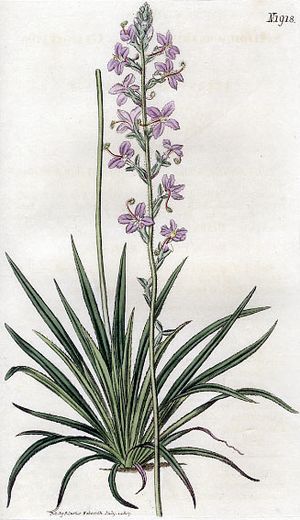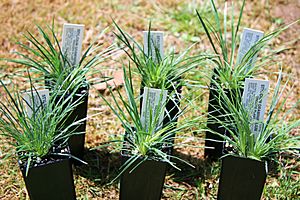Grass triggerplant facts for kids
Quick facts for kids Grass triggerplant |
|
|---|---|
 |
|
| S. graminifolium flowers | |
| Scientific classification | |
| Genus: |
Stylidium
|
| Species: |
graminifolium
|
| Synonyms | |
|
Candollea serrulata Labill. |
|
The grass triggerplant, also known as Stylidium graminifolium, is a special type of plant. It belongs to a group of plants called dicotyledons and is part of the Stylidium genus. These plants are famous for their unique "trigger" pollination system.
S. graminifolium is found only in Australia. It has one of the widest distributions of all Stylidium species across the country. This plant is a perennial, meaning it lives for more than two years. It has leaves that look like grass and is quite easy to grow. Scientists think it might be a carnivorous or protocarnivorous plant. This is because it has sticky hairs under its flowers that can trap and digest small insects.
Contents
What Does the Grass Triggerplant Look Like?
This plant is an upright herb that lives for many years. Its narrow, grass-like leaves grow from the base in a circular shape, like a rosette. These leaves can be 5 to 40 centimeters (2 to 8 inches) long.
In spring and summer (October to February), a tall stem called a scape grows from the plant. This stem can be 15 to 90 centimeters (6 to 36 inches) long. It holds a cluster of flowers called a racemous inflorescence. The flowers look like butterflies and are usually pale or bright pink. Their petals are arranged in pairs on the sides.
Both the outer leaf-like parts of the flower (the calyx) and the petals (the corolla) are covered in sticky, glandular hairs called trichomes.
The Amazing Trigger Mechanism
The Stylidium family has a very special way of pollination. It involves a sensitive "trigger." This trigger is a floral column where the male parts (the stamen) and female parts (the style) of the flower are joined together. In S. graminifolium, this column is red, and the stamens are greenish.
When an insect lands on the flower, the trigger quickly snaps down, dusting the insect with pollen. This helps the plant spread its pollen to other flowers.
Is it a Carnivorous Plant?
Like most Stylidium species, S. graminifolium has sticky, glandular hairs under its flowers and on its stem. These hairs can trap small insects in their sticky mucilage. Some researchers believe these plants can then digest and absorb nutrients from the trapped prey. This suggests that they might be carnivorous or at least protocarnivorous (meaning they have some traits of carnivorous plants).
Where Does the Grass Triggerplant Grow?
S. graminifolium grows in many parts of Australia. You can find it from Tasmania up through Victoria, New South Wales, and Queensland, and even into South Australia.
It usually lives in dry sclerophyll forests. These are forests with tough, leathery-leaved plants. The soil in these areas often does not have many nutrients.
How Was the Grass Triggerplant Discovered?
Stylidium graminifolium was one of the first four Stylidium species ever collected. This happened in 1770 at Botany Bay. Joseph Banks and Daniel Solander found it while they were with James Cook on his first voyage to the Pacific Ocean aboard the Endeavour.
The plant was officially described for the first time by Carl Ludwig Willdenow in 1805. Then, just two years later in 1807, Olof Swartz also described it using the same name. For a while, some botanists thought these new plants should be in a different group called Candollea. However, the name Stylidium was kept because it was used first. The plant was then placed in its own plant family, Stylidiaceae.
The Stylidium graminifolium Group
After S. graminifolium was discovered, scientists found other similar plants. They grouped them together in what was called the Stylidium graminifolium complex. This was a group of plants that looked alike but had some important differences.
In 2001, scientists decided to split this complex into three separate species. S. graminifolium was kept as the main species, based on the original plants collected by Banks and Solander. The other two species that used to be part of this group are S. dilatatum and S. armeria. These three species also grow in different types of places. S. graminifolium is found widely in southeastern Australia and Tasmania. S. dilatatum grows in cooler, higher areas of southeastern Australia and Tasmania. S. armeria prefers coastal areas in Tasmania.
Growing the Grass Triggerplant
Stylidium graminifolium is one of the few triggerplant species that you can buy as seeds. A scientist named Douglas Darnowski studied this plant in the United States from 2000 to 2002. He wanted to see how well it would grow and how well it could handle cold weather.
His study showed that S. graminifolium could survive cold temperatures down to -10°C. This means it can be grown outdoors in many places, even in areas with cold winters (like USDA hardiness zone 8).
Dr. Darnowski also thought that the plant's pretty flower spikes could be used in floriculture, which is the growing of flowers for decoration. He suggested it could even replace plants like purple loosestrife in flower arrangements during winter and spring.
This plant flowers for a relatively long time. It also has specific needs for its seeds to sprout. For example, they often need smoke treatments and warmer temperatures, similar to what happens after a bushfire. This helps prevent it from becoming an invasive species in new areas. It can also grow in poor soils and handle dry periods. All these things make it a good choice for growing in gardens.
There are two special types, or cultivars, of S. graminifolium that are recognized by the Royal Horticultural Society. They are called Tiny Trina and Little Saphire. 'Little Saphire' has bright blue leaves, which makes it different from the usual plant. 'Tiny Trina' has darker pink flowers and darker green leaves. It also starts to flower later in the season.



